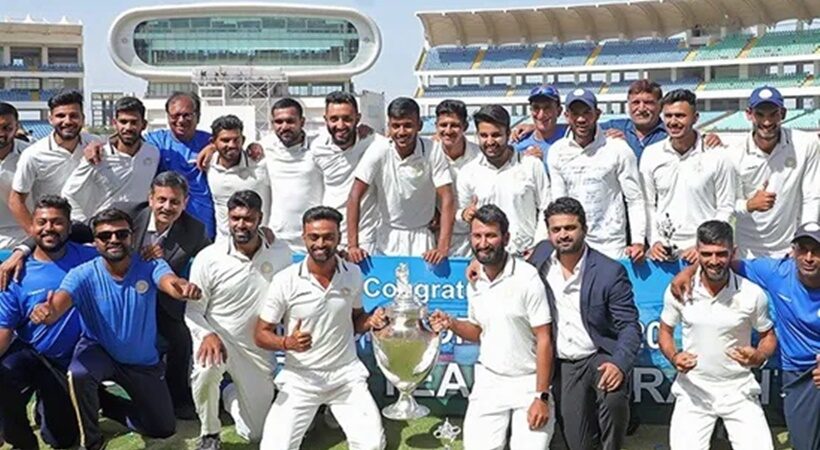After missing the 2020-21 season due to the pandemic, Indian cricket’s most prestigious and precious domestic tournament Ranji Trophy is all set to begin this year in two phases. In recent times, the relevance of the national cricket competition of the country has gradually declined, thanks to the advent of the T-20 format and the subsequent birth of the cash-rich IPL league.
The matches of the tournament are mostly played before near-empty stands and there is no enthusiasm with the cricket-mad Indian public about the outcomes as well. Despite the razzmatazz of the slam-bang version of the game accentuated to a great extent by dollops of glitz and glamour Ranji Trophy has not lost its charm amongst the connoisseurs of the game. The domestic championship has a special place in the hearts of genuine lovers of the sport for its rich legacy that has produced some finest talents in Indian cricket. Hence, it is not at all a bad time to explore the fascinating aspects of India’s premier domestic tournament.
How It Got Its Name?
The co-founder of the Board of Control for Cricket in India (BCCI) Anthony de Mello was the main architect of the Ranji Trophy. He devised the plan of holding a national cricket championship and also showed the sketch of the trophy- a Grecian urn – during a BCCI meet in Shimla in 1934. This gave birth to the Cricket Championship of India, which was later on rechristened as Ranji Trophy when the then Maharaja of Patiala Bhupendra Singh agreed to back the same financially.
The tournament was named after the Legendary Sir Maharaja Ranjitsinhji Vibhaji Jadeja, the Maharaja of Nawanagar. Ranjitsinhji happened to be the first Indian cricketer to have played international cricket, but for England while representing Cambridge University, Sussex and England national team.
Short Inaugural Season
In the introductory Ranji Trophy, Madras locked horns with Mysore at the Chepauk Ground. Madras then humbled the visiting team by an innings and 23 runs as the game finished five minutes before the end of the first day’s play. However, this was the only match to conclude on day one in the history of the Ranji Trophy.
Just 15 teams took part in the inaugural season, which had 13 games with merely three matches producing outcomes. Bombay defeated Northern India in the final, courtesy of Vijay Merchant’s multi-skilled abilities.
The Format Has Undergone Numerous Tweaks
The format of the tournament did not see any change till 2001, when teams were classified into various geographic zones—north, south, east, west and central—and the victors from each zone clashed with one another in do or die encounters to decide the winner. In the 2002-03 season, the zonal system was eliminated for a two-tier system.
As per the new system, the elite group with the best 15 teams and the remaining teams clashed in the plate group. The numero uno teams from the plate group then progressed to the elite group, and the ones ending up at the lowest part of the elite group got downgraded. Even this format went through some changes in the past few years with the expansion of several groups, thereby permitting more teams the opportunities to grab the trophy. The 2018-19 season had nine teams making their Ranji debuts and also witnessed the addition of a fourth group apart from the three already in existence.
Point System Has Its Share Of Supporters & Detractors
The Ranji has given Indian cricket some jewels in its crown: Sunil Gavaskar, Sachin Tendulkar, Kapil Dev, Rahul Dravid etc. The reason for producing such fine talents has been attributed to its point system. The trophy has a system of awarding points based on first-innings lead, wherein teams with the highest total in their first essays are awarded 3 points. So, if a team wins convincingly it gets 6 points and in case of a draw, the team with a big first-innings total gets substantially rewarded to progress further in the tournament.
In the knockout stage, the first innings lead is used as the criterion to decide the winner if the match ends without a clear winner. This rule might have motivated batters to stay put at the crease for longer durations to score a lot of runs but it discourages the culture of winning the test matches as it has spawned many farcical games as well. This aspect of the point system has often come under fire from several quarters.
Switch Sides Without Hiccups
The Ranji Trophy also allows a player to change teams as it does not force the individual to stick with the home team. Resultantly, several players in the Ranji have started with one team and then ended their careers with a different team. This has aided several players in extending their careers as well as in making a move to a better team.
For example, Irfan Pathan started his domestic journey with Baroda, but towards the end of his career shifted to Jammu and Kashmir. Even Virender Sehwag made his Ranji debut with Delhi, but he eventually retired as a Haryana player. This is the only tournament in India that allows this kind of flexibility to the players.



















